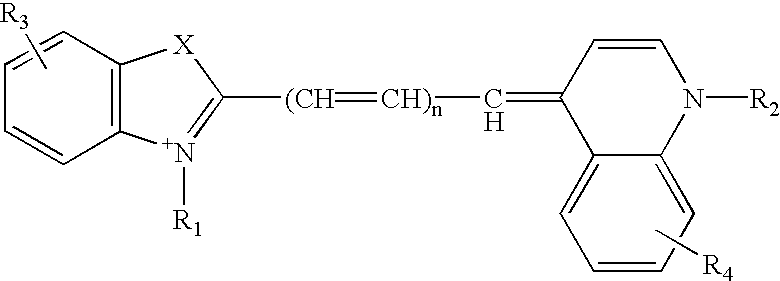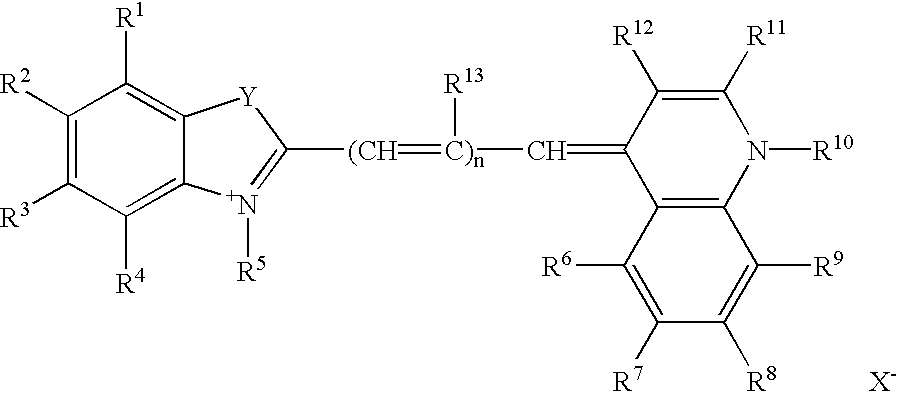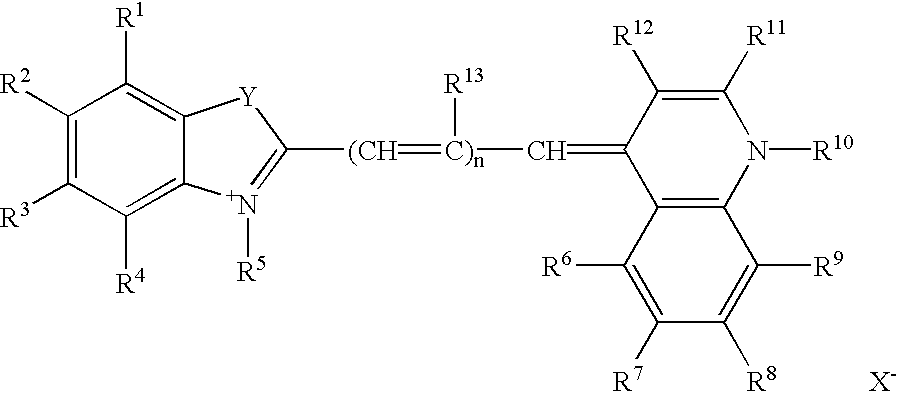Helium-neon excitable reticulocyte dyes derivable from halolepidines
a technology of helium-neon and excitable reticulocytes, which is applied in the field of dyes, can solve the problems of inaccurate counts and/or false positives of specific cell types of interest, slow method, and tediousness,
- Summary
- Abstract
- Description
- Claims
- Application Information
AI Technical Summary
Benefits of technology
Problems solved by technology
Method used
Image
Examples
example i
Preparation of 7-chlorolepidine
[0093]To a mixture containing 3-chloroaniline (1.59 g), ferric chloride hexahydrate (5.4 g), zinc chloride (0.2 g), ethanol (20 ml of 95% aqueous solution) preheated to 60° C. was added 1,3,3-trimethoxybutane (1.48 g). The resulting mixture was refluxed for two hours and allowed to stand overnight. The volatile matrials were then removed in vacuo and the residue rendered basic with 10% aqueous sodium hydroxide. The resulting mixture was partitioned between water and diethyl ether (3 times). The combined ether layer was dried over magnesium sulfate. Rotary evaporation of the ether solution gave a dark liquid. The liquid was added to a silica gel column and eluted with hexane / ethyl acetate (3:1) to give the desired product as tan crystals.
Preparation of 7-chloro-1-methyllepidinium iodide
[0094]A portion of the 7-chlorolepidine (80 mg) prepared as above was methylated by heating with CH3I (0.5 ml) in CH3CN (1 ml) at reflux for two hours. The mixture was tr...
example ii
Preparation of Dye 8
[0097]The procedure described for the preparation of Dye 7 was followed, with the exception that 2,3-dimethylbenzothiazolium iodide was substituted for 3-ethyl-2-methylbenzothiazolium iodide in EXAMPLE I. The dye also had an absorption maximum at 638 nm in methanol.
example iii
Preparation of Dye 9
[0098]The procedure described for the preparation of Dye 7 was followed, with the exception that 2,3-dimethylnaphthoxazolium iodide was substituted for 3-ethyl-2-methylbenzothiazolium iodide in EXAMPLE I. The dye had an absorption maximum of 624 nm in methanol.
PUM
| Property | Measurement | Unit |
|---|---|---|
| Nanoscale particle size | aaaaa | aaaaa |
| Nanoscale particle size | aaaaa | aaaaa |
| Nanoscale particle size | aaaaa | aaaaa |
Abstract
Description
Claims
Application Information
 Login to View More
Login to View More - R&D
- Intellectual Property
- Life Sciences
- Materials
- Tech Scout
- Unparalleled Data Quality
- Higher Quality Content
- 60% Fewer Hallucinations
Browse by: Latest US Patents, China's latest patents, Technical Efficacy Thesaurus, Application Domain, Technology Topic, Popular Technical Reports.
© 2025 PatSnap. All rights reserved.Legal|Privacy policy|Modern Slavery Act Transparency Statement|Sitemap|About US| Contact US: help@patsnap.com



